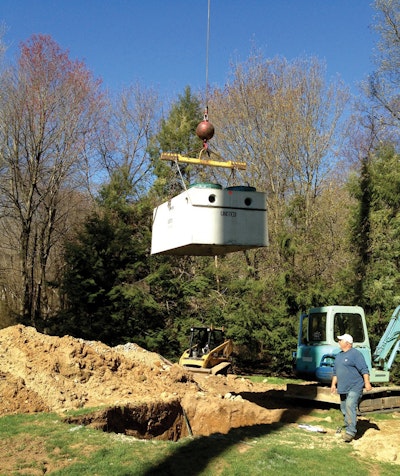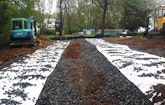
Interested in Accessories?
Get Accessories articles, news and videos right in your inbox! Sign up now.
Accessories + Get AlertsA 300-gallon steel septic tank collapsed at a three-bedroom home in residential Prospect, Conn., producing a sinkhole in the backyard that was a safety hazard to the homeowners’ young child and family dog.
A contractor recommended Mark Green, owner of Green Construction Management in Waterbury, Conn., who immediately dug test pits and spent two days with the Chesprocott Health District inspector designing a conventional gravity system the homeowners could afford.
“We couldn’t move a holding tank to the backyard because trees barred our route around the south side of the house, and a testy neighbor wouldn’t allow us to cross the property line on the north side,” says Green. “The rear of the 230- by 100-foot-wide lot abutted woods.”
With raw sewage discharging to the ground, the district’s cooperation enabled Green to set the new septic tank in five days. Then unexpected challenges put him two weeks behind schedule and stretched a seven- to 10-day job over 14 intermittent days.
Site conditions
Soils are sandy gravel with a percolation rate of 10 to 20 minutes per inch and mottling at 30 inches. The lot, sloping 8 degrees toward the rear, has a 100-foot-wide protruding rock ledge in the southwest corner.
System components
Green designed the system to treat 750 gpd. Components are:
- 1,000-gallon dual-compartment concrete septic tank from United Concrete Products, Wallingford, Conn.
- PL-122 Polylok effluent filter
- 32 Contactor 100 chambers (CULTEC)
System operation
Wastewater flows 40 feet though a 4-inch PVC Schedule 40 lateral into the septic tank, out the filter and through a 4-inch Schedule 35 pipe discharging to an overflow distribution box. It feeds double rows of two chambers to the left and six to the right. A second distribution box 12 feet downstream splits the overflow to an identical array of chambers set 12 inches lower.
Installation
Meeting setbacks on the narrow lot left 3.5 feet of wiggle room between property lines. The ledge forced Green to move the tank farther north than desired, putting it in the failed drainfield and off-center from the lateral. He worked for two days with Gina Carolan, chief operating officer and director of marketing at CULTEC, to design the 67- by 20-foot drainfield. The chambers reduced sizing requirements by 50 percent.
“We kept jockeying the 32 chambers around, trying to make them fit while maintaining grade,” says Green. “Mottling limited their depth to 30 inches, but if we raised the tank too high to achieve the proper pitch, we’d need a ton of fill.” The solution split the drainfield, creating 15-foot-long trenches on the left and 52-foot-long trenches on the right. They avoided pump systems to remain within the owner’s budget.
Using a Volvo EC35 rubber-tracked mini excavator that just fit between the house and property line, Green dug a 6.5-foot-deep hole for the tank and stockpiled the spoil. Septic gravel and screened topsoil, staged on the front lawn, were transported with a Caterpillar 277 tracked skid-steer. He bedded the hole with 6 to 8 inches of stone, while Wayne Green, his father, leveled it using a laser rod and LL500 laser level (Spectra Precision).
At 7 a.m. the next morning, United Concrete off-loaded the two tank halves, rigged in wire slings. George Schrada, owner of A-Quick Pick Crane and Rigging Service from Derby, Conn., parked a 70-ton crane with 100-foot boom in the front yard, then lifted the bottom half of the tank 45 feet off the ground.
While it dangled, Mark Green waited for the district office to open at 8 o’clock. “I had only a verbal permit with them,” he says. “The moment the form was signed, I called George to set the tank.”
Wayne Green and Schrada used two-way radios to communicate as the crane swung the tank 90 feet over the house and into the hole. Setting each half took 10 minutes. “We had one shot to get it right,” says Green. “If we set the top half crooked, the rubber urethane seal on the rim of the bottom half wouldn’t allow us to separate the pieces and try again.”
Because of the slope, one side of the tank protruded 6 inches above grade. Mark Green feathered the exposed face into the hill with gravel, then backfilled around the tank with spoil.
As he excavated near the ledge for the 5-foot-deep trenches, he uncovered an old dump site filled with car parts, tires, bottles and trash. Only a Ford F-550 with a 4-cubic-yard dump body was small enough to reach the backyard. “It took three days for Dad and me to remove the material and bed the trenches with 36 inches of gravel,” says Green.
With heavy rains predicted the next day, Green called Tom Dauti, owner of Dauti Masonry in Prospect, to help shuttle stone and install the 96- by 36- by 12.5-inch-high chambers 26 inches deep. Working late into the night, they backfilled to the crowns with 1.25-inch stone, covered the chambers with No. 410 nonwoven filter fabric (CULTEC) and added 6 to 8 inches of topsoil.
Restoring the side and front yards required more topsoil, legwork and an additional two days.
Maintenance
Green educated the homeowners about their system. The state Department of Public Heath requires pumpouts every three to five years.








